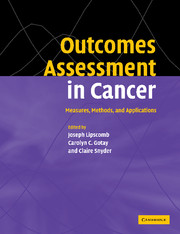Book contents
- Frontmatter
- Contents
- List of contributors
- Acknowledgments
- 1 Introduction to Outcomes Assessment in Cancer
- Health-related quality of life in cancer: general concepts and generic measures
- Assessing health-related quality of life during treatment
- Assessing health-related quality of life across the cancer continuum
- Measuring the experience and needs of cancer patients and caregivers
- Methodological considerations in applications to cancer outcomes research
- Modern psychometric theory in cancer outcomes research
- Assessing the economic impact of cancer
- Research and policy implications
- Invited papers
- Invited Paper A The world of outcomes research: yesterday, today, and tomorrow
- Invited Paper B The ten Ds of health outcomes measurement for the twenty-first century
- Invited Paper C The use of cognitive interviewing techniques in quality of life and patient-reported outcomes assessment
- Invited Paper D Industry perspective regarding outcomes research in oncology
- Index
- References
Invited Paper B The ten Ds of health outcomes measurement for the twenty-first century
Published online by Cambridge University Press: 18 December 2009
- Frontmatter
- Contents
- List of contributors
- Acknowledgments
- 1 Introduction to Outcomes Assessment in Cancer
- Health-related quality of life in cancer: general concepts and generic measures
- Assessing health-related quality of life during treatment
- Assessing health-related quality of life across the cancer continuum
- Measuring the experience and needs of cancer patients and caregivers
- Methodological considerations in applications to cancer outcomes research
- Modern psychometric theory in cancer outcomes research
- Assessing the economic impact of cancer
- Research and policy implications
- Invited papers
- Invited Paper A The world of outcomes research: yesterday, today, and tomorrow
- Invited Paper B The ten Ds of health outcomes measurement for the twenty-first century
- Invited Paper C The use of cognitive interviewing techniques in quality of life and patient-reported outcomes assessment
- Invited Paper D Industry perspective regarding outcomes research in oncology
- Index
- References
Summary
Introduction
The origins of health status assessment can be traced to the 1960s and the need at that time for a new armamentaria of health statistics to measure outcomes above and beyond mortality and morbidity. The state of health outcomes assessment in the 1960s has been characterized by the five Ds: death, disease, disability, discomfort, and dissatisfaction. In the USA, death registration was standardized in most states by 1930 and disease surveys had been underway since the late 1880s.– Measurement of disability began in the 1930s– but earnestly gained momentum in the late 1950s.– The National Health Interview Survey, which is a major source of information on disease and disability, was instituted in 1957 and continues today. Measurement of discomfort (subjective and objective sickness impacts) began in the 1940s, and continues to constitute a significant component of health-related quality of life (HRQOL) surveys. Measurement of patient satisfaction commenced in the 1950s for mental health care, and the 1960s for general medical care.
We have made great progress in measuring patient health outcomes since the five Ds were first propounded. There are over 85 tools that measure basic and instrumental activities of daily living. Myriad measures of depression exist. Close to two dozen generic HRQOL instruments have been developed. Hundreds of disease-specific instruments abound., In cancer, over 75 different HRQOL measures exist. The vast majority of these measures have been created under the umbrella of classical test theory (CTT).
- Type
- Chapter
- Information
- Outcomes Assessment in CancerMeasures, Methods and Applications, pp. 590 - 609Publisher: Cambridge University PressPrint publication year: 2004
References
- 1
- Cited by



